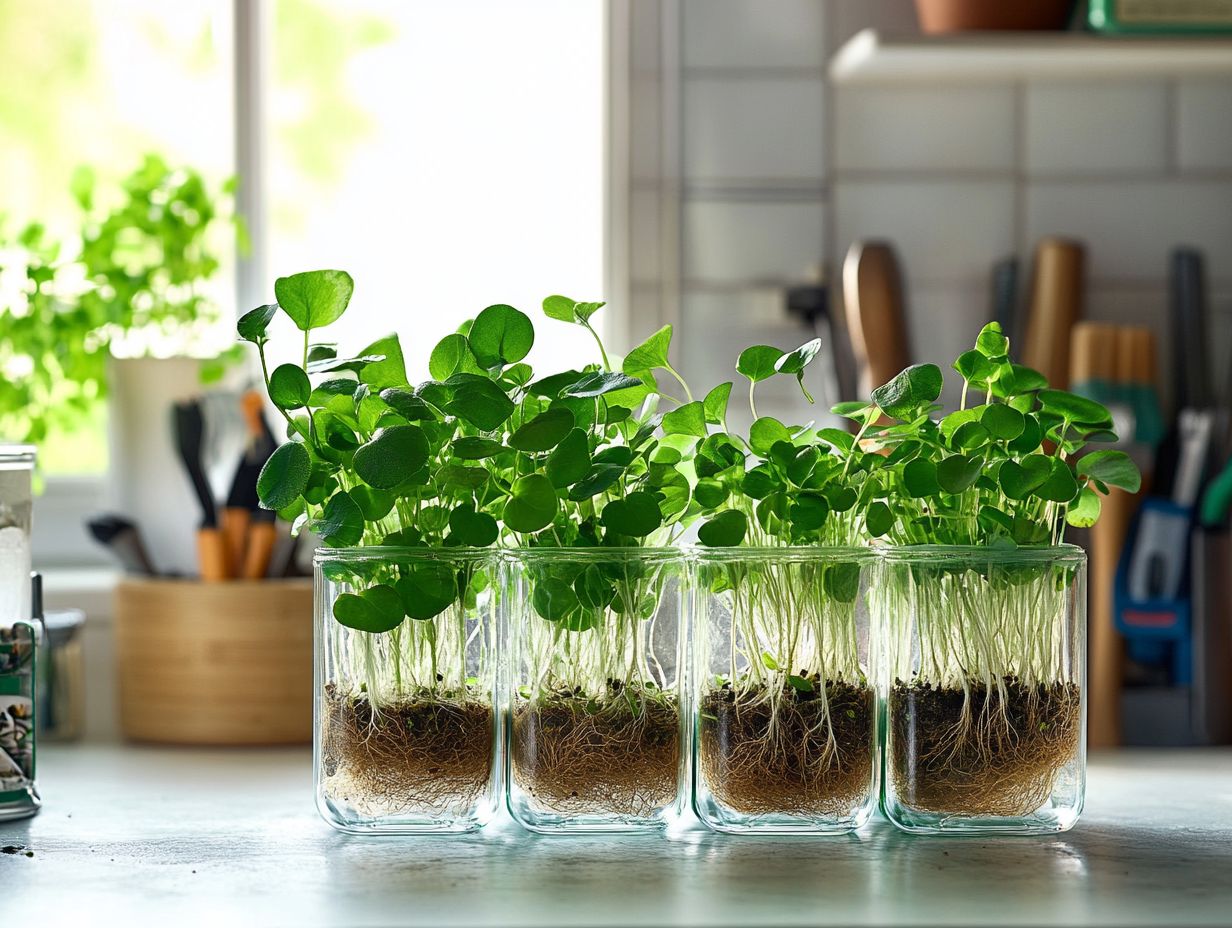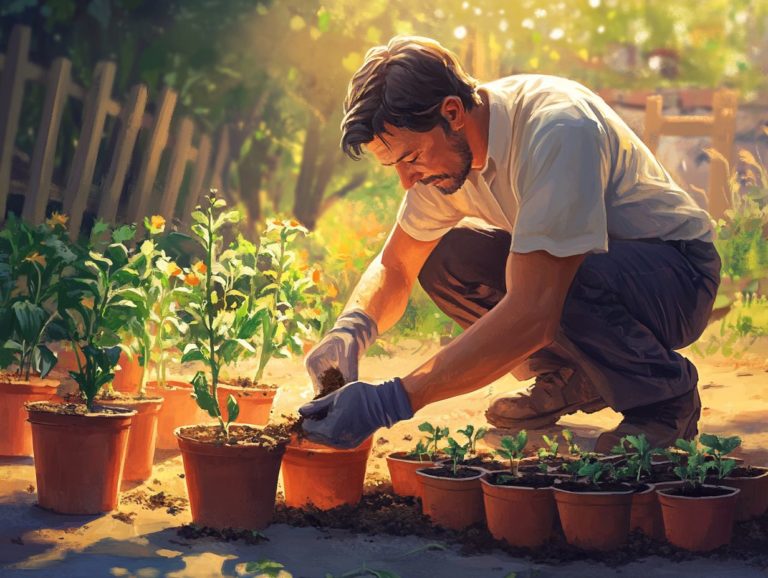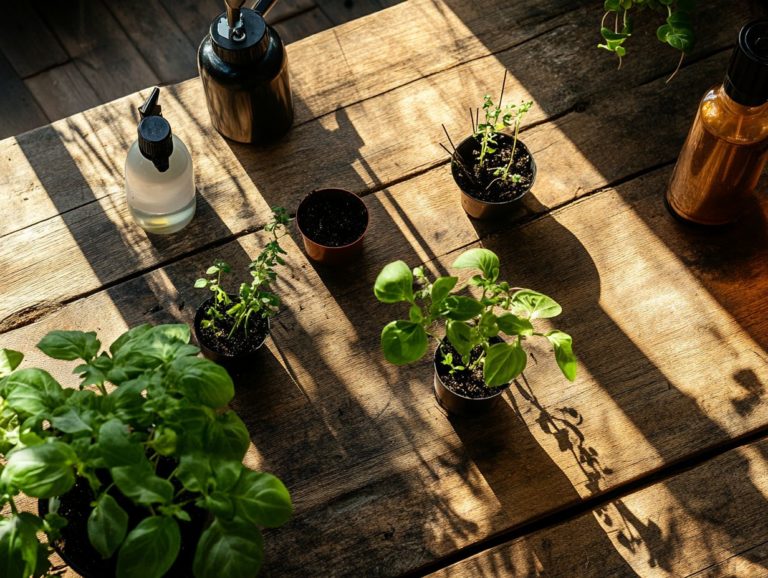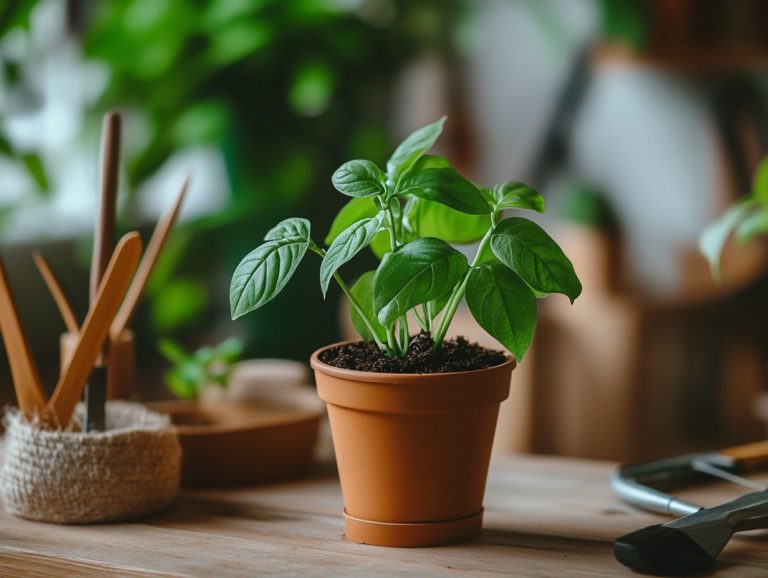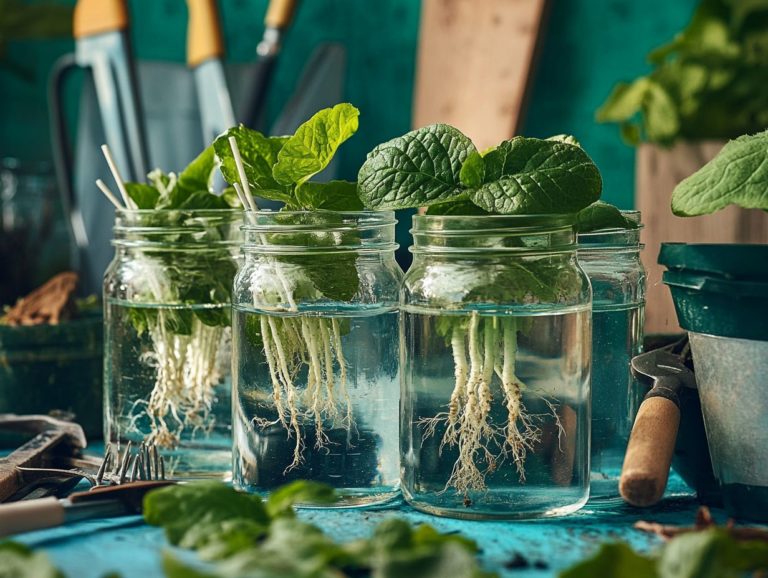The Best Indoor Plants for Hydroponic Propagation
Are you ready to take your indoor gardening to the next level? Hydroponic propagation presents an intriguing opportunity to cultivate plants without soil, optimizing both space and efficiency!
This guide delves into the finest indoor plants suited for hydroponic systems, featuring delightful options like herbs, leafy greens, and even fruits such as strawberries and tomatoes.
You ll find important tips for successful propagation, addressing lighting and nutrient requirements along with common troubleshooting techniques.
Ready to transform your space into a vibrant oasis? Let s dive into setting up your hydroponic garden!
Contents
- Key Takeaways:
- 4. Best Indoor Plants for Hydroponic Propagation
- 5. Must-Know Tips for Thriving Hydroponics!
- Frequently Asked Questions
- What are the best indoor plants for hydroponic propagation?
- Why are these plants ideal for hydroponic propagation?
- Do these plants require any special care in a hydroponic system?
- Can I grow other types of plants using hydroponic propagation?
- What are the benefits of using hydroponic propagation for indoor plants?
- Are there any downsides to using hydroponic propagation for indoor plants?
Key Takeaways:
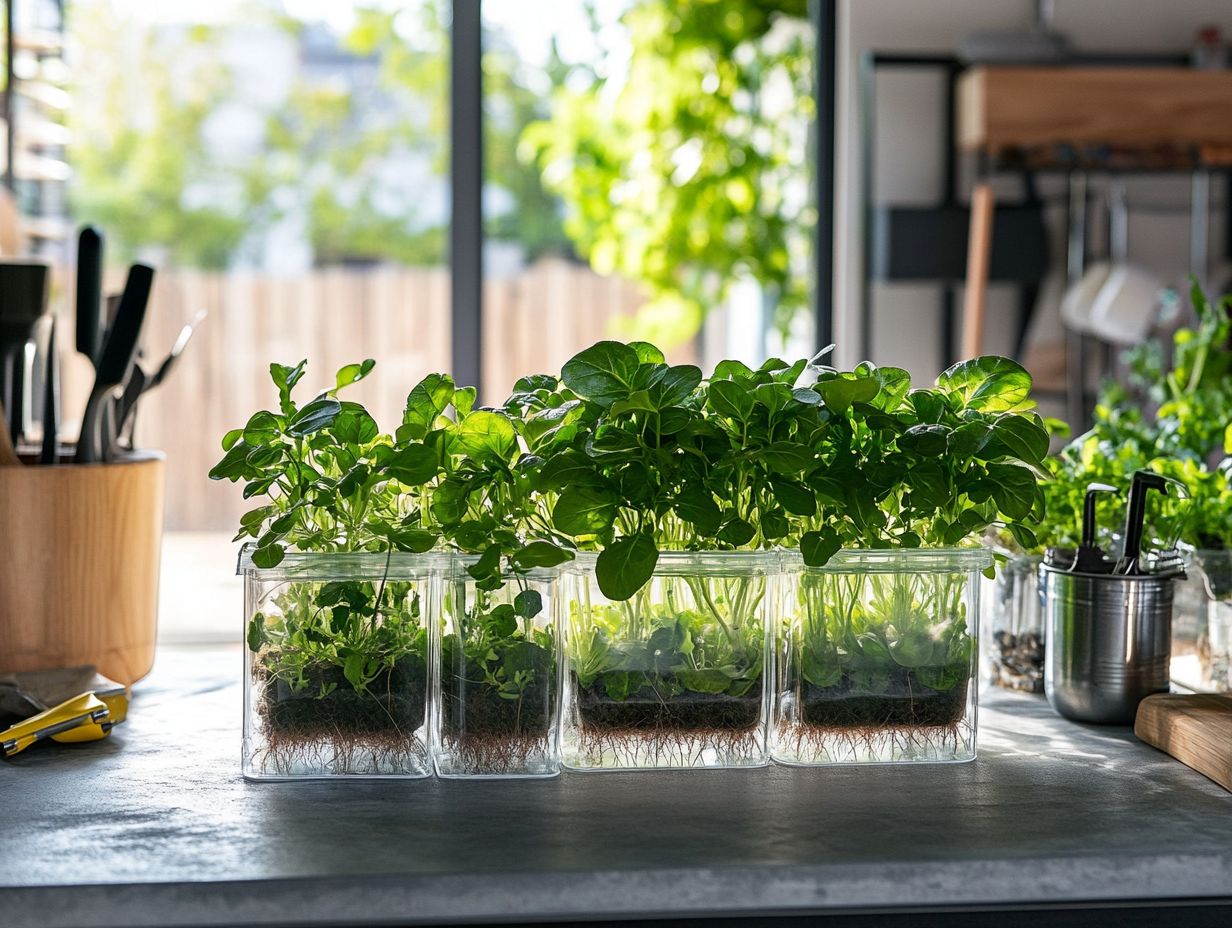
- 1. Grow a variety of plants with hydroponic propagation, such as herbs, leafy greens, succulents, and more.
- 2. Ensure success by following key tips, including proper lighting, adequate nutrients, and regular maintenance.
- 3. Troubleshoot common issues with temperature, humidity, and nutrient imbalances to achieve healthy and thriving plants.
4. Best Indoor Plants for Hydroponic Propagation
Selecting the right indoor plants is essential for you as an indoor gardener aiming to cultivate both efficiency and beauty in your home.
Beyond the beloved Spider Plant, Lucky Bamboo, and Peace Lily, consider incorporating a diverse array of leafy greens like lettuce and spinach. These plants thrive thanks to their shallow root systems and rapid growth rates. For those looking to expand their gardening skills, exploring the top 5 methods for indoor plant propagation can be incredibly beneficial.
Tropical varieties, like the Fiddle Leaf Fig and Philodendron, also shine in this environment, offering stunning foliage while purifying the air. Each of these plants has its own light preferences: leafy greens flourish under bright, indirect sunlight, whereas tropical species tend to appreciate filtered light.
To keep your hydroponic garden vibrant, perform regular water changes generally every two weeks. Additionally, monitor nutrient levels and ensure adequate aeration. These practices will boost the health and productivity of your indoor garden, allowing your plants to thrive spectacularly!
4.1. Herbs
Herbs rank among the most gratifying plants to cultivate hydroponically, flourishing in moisture-rich environments while bestowing fresh flavors for your culinary creations. This makes them a favored choice for indoor gardening.
Among the elite contenders for hydroponic growth, basil truly shines, thanks to its aromatic leaves and relatively modest nutrient demands. It thrives in a balanced nutrient solution, requiring just a touch of warmth to unlock its full potential. To enhance your indoor gardening experience, learn about the best time to propagate your indoor plants.
Rosemary prefers a Mediterranean-inspired setup, thriving in well-drained conditions with less moisture. Mint, another beloved option, is known for its vigorous growth and enjoys consistently moist conditions to develop its robust flavor.
Incorporating these vibrant herbs into your kitchen d cor not only elevates your culinary endeavors but also infuses your indoor space with a touch of natural beauty.
4.2. Leafy Greens
Leafy greens are an exceptional choice for hydroponic propagation, thanks to their rapid growth and impressive nutritional value making them a must-have for the discerning indoor gardener focused on health.
Among these, lettuce, spinach, and kale shine, delivering vibrant flavors and essential vitamins. Maintain optimal moisture levels, typically between 70-80%, to prevent both dehydration and root rot.
Regularly checking the nutrient solution will be key to ensuring robust growth; utilizing water-soluble fertilizers allows you to supply necessary minerals directly to the roots. Keeping your grow trays clean and monitoring pH levels will elevate the success of your leafy green harvest to new heights.
Start your hydroponic garden today and reap the rewards of fresh produce right at home!
4.3. Succulents
Succulents usually grow in soil. However, some types can thrive in hydroponic systems. This offers a unique and decorative option for indoor gardeners like you who appreciate low-maintenance beauty.
Among these adaptable plants, Echeveria and Jade Plant emerge as stellar choices for hydroponic cultivation. They flourish in bright, indirect light. Positioning them near a sunny window is ideal for their growth.
They prefer lower humidity, but striking the right balance is crucial. Monitor water levels diligently. Too much water can lead to root rot, which is a gardener’s nightmare. Ensure that your hydroponic setup has the right plant food. This will help your succulents show vibrant colors and stay healthy.
With a bit of attention to these care requirements, you can watch these succulents flourish beautifully in a hydroponic environment.
4.4. Orchids
Orchids are exquisite indoor plants. You can successfully propagate them hydroponically, adding stunning decorative accents to your space while requiring specific care for proper root growth and moisture levels.
You may find yourself drawn to varieties like Phalaenopsis, celebrated for their large, vibrant blooms. These beautiful plants demand bright, indirect light, carefully shielded from harsh sunrays that could scorch their delicate leaves.
High humidity levels ideally between 50% and 80% are crucial for their well-being. Regularly check their roots. They should remain moist but never waterlogged. Using a well-draining medium can effectively prevent root rot.
By adopting these practices, you ensure that your orchids flourish. They will transform into captivating focal points in any indoor setting.
4.5. Tomatoes
Growing tomatoes hydroponically allows you to savor delicious fruits while maximizing your indoor gardening space. With the right care and nutrient management, you can enjoy fresh produce all year round.
Many tomato varieties thrive in hydroponic systems, including cherry, beefsteak, and Roma tomatoes. Each type has its unique light exposure requirements, typically needing around 14 to 18 hours of light daily.
To cultivate robust plants, closely monitor your nutrient solution. Ensure that key elements like nitrogen, phosphorus, and potassium are balanced. Regular water changes, usually every two weeks, are vital for preventing toxicity and promoting healthy root development, especially for leafy greens.
With this approach, you’ll be well on your way to a bountiful tomato harvest. Don t miss out on the chance to enjoy fresh tomatoes year-round!
4.6. Peppers
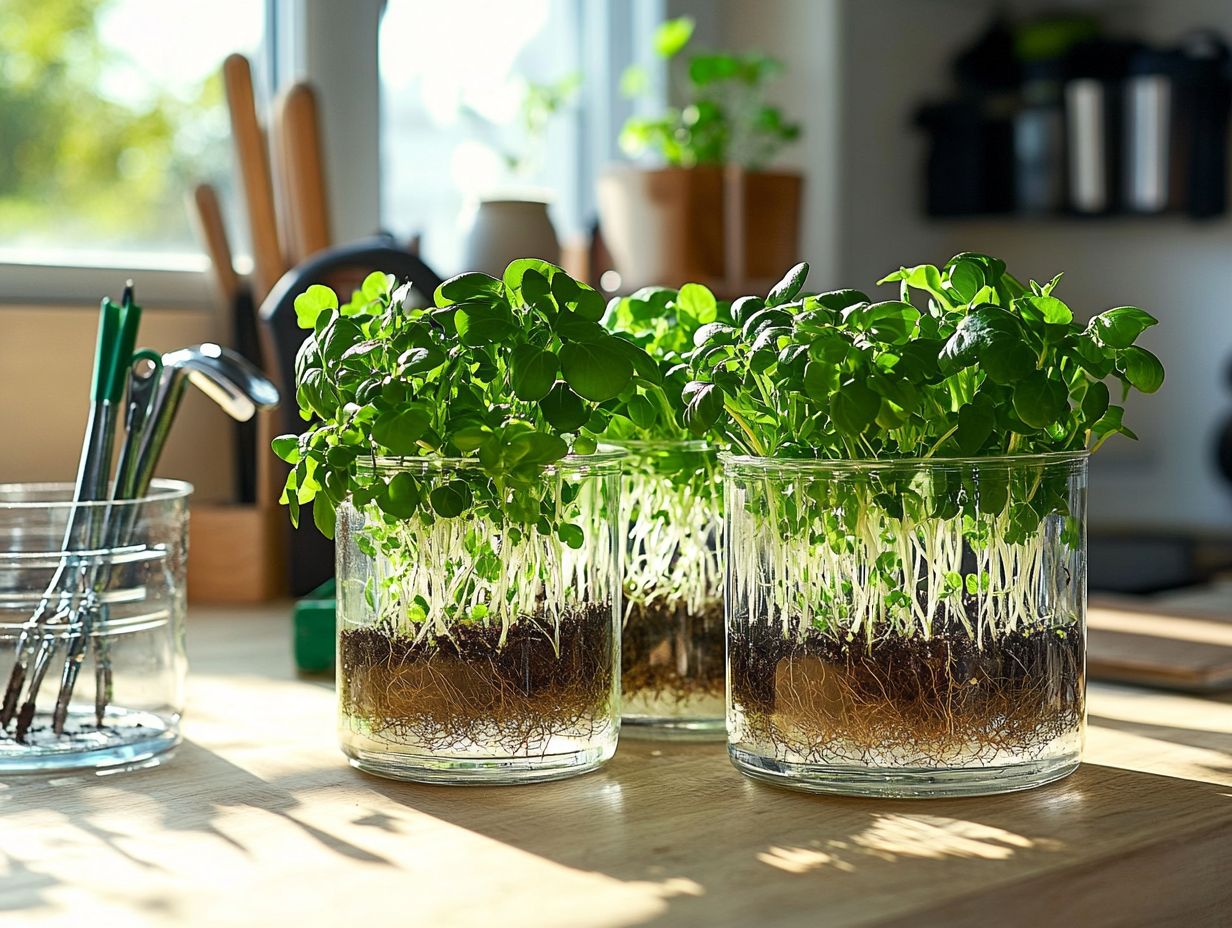
Peppers are not just colorful; they re a delightful addition to your indoor garden. They thrive beautifully in hydroponic setups. Grow peppers that not only look stunning but also provide a bountiful harvest!
Among the many varieties you can cultivate hydroponically, bell peppers, jalape os, and habaneros shine with their adaptability and impressive yields. Each type has its own unique care requirements, such as temperature control, light exposure, and specific nutrient levels essential for optimal growth.
Your watering techniques will play a vital role. Consider utilizing methods like nutrient film or deep water culture to maintain the right moisture balance. With these strategies, you can ensure your plants stay hydrated without the risk of too much water.
Don t underestimate the power of robust root development. Incorporating aeration stones or choosing a high-quality growing medium can significantly boost root health and nutrient uptake. Ultimately, this will lead to a flourishing pepper garden that not only looks good but also rewards you with fresh, flavorful produce.
4.7. Strawberries
Strawberries can be a great addition to your hydroponic garden, bringing both visual charm and the promise of sweet, fresh fruits without the need for soil.
To cultivate these juicy berries successfully, you must provide the right care conditions. Light exposure is critical; strawberries thrive best with 12 to 16 hours of bright light each day, ideally from LED or fluorescent grow lights.
Maintaining adequate moisture is essential. The roots should never dry out, so regularly monitoring the water levels in your hydroponic system is vital. Don’t overlook nutrient delivery, either. Strawberries require a balanced mix of nitrogen, phosphorus, and potassium to promote healthy growth and abundant fruiting.
With the right setup and diligent maintenance, you can enjoy vibrant strawberry plants and a bountiful harvest right in your indoor space. Consider using propagation stations for indoor plants to enhance your gardening experience. Don’t wait! Start your hydroponic garden today!
4.8. Cucumbers
Cucumbers are refreshing and versatile, thriving in hydroponic environments. They offer you, as an indoor gardener, a continuous supply of crisp produce while simplifying your plant care routine, making them a great choice alongside tomatoes and peppers.
To unlock their full growth potential, it’s essential to grasp the specific light exposure requirements of these crops. Cucumbers truly shine under consistent, bright illumination. Adequate lighting not only fuels healthy vine growth but also sparks robust fruit production.
It s vital to ensure they receive the right nutrient mix. A balanced solution featuring key macronutrients like nitrogen and potassium, along with trace minerals, can significantly boost overall crop health.
While cucumbers are quite resilient, growing them hydroponically does present its own set of challenges. You’ll need to manage humidity levels and fend off pests, which are necessary tasks to maintain a productive and thriving system. Embrace these challenges, and you’ll reap the rewards of your hydroponic endeavors. Consider using glass jars for your setup as an alternative.
4.9. Beans
Beans are a remarkable choice for hydroponic propagation, thanks to their rapid growth and nutrient-dense profile. This means you can enjoy the benefits of fresh produce even in limited indoor spaces.
These legumes thrive beautifully in hydroponic systems while offering a delightful array of varieties, each with its own unique care requirements and ideal moisture levels. Varieties like green beans and kidney beans flourish in environments where water and nutrients are meticulously managed.
Balancing moisture is crucial. Too little water stunts growth, but too much can rot the roots.
From a nutritional standpoint, beans shine as a powerhouse of protein, fiber, and essential vitamins, making them a valuable addition to any diet. By understanding the specific needs of different bean varieties, you’ll be amazed at how much you can grow.
4.10. Microgreens
Microgreens are nutrient-packed powerhouses that grow swiftly in hydroponic systems, making them a prime choice for those looking to maximize health benefits in a compact space.
These diminutive greens, including delightful varieties like radish, broccoli, and basil, thrive in well-lit environments typically basking in around 12 to 16 hours of light each day.
Each type of microgreen offers its own unique flavor profile and a wealth of vitamins. For instance, sunflower and pea shoots are rich in essential minerals that not only bolster immunity but also enhance overall well-being.
Caring for these little wonders is relatively straightforward. With just the right balance of moisture and nutrients and thanks to their rapid growth cycle you can enjoy fresh greens in as little as a couple of weeks.
4.11. Fruits
Growing fruits hydroponically is not just an exciting endeavor. It’s a gateway for you, the indoor gardener, to cultivate a delightful array of flavors.
From strawberries to blueberries, a wide range of fruits thrives in these soilless systems, each with its own unique set of care requirements. Take strawberries, for example; they need a balanced pH level and thrive on consistent moisture. On the other hand, tomatoes are all about that ample light and warmth to flourish.
Don’t underestimate the importance of proper water changes. These are essential for preventing nutrient buildup and maintaining a fresh solution. You’ll want to monitor nutrient delivery closely, making adjustments to the solutions to match the specific growth stages of your plants.
This attention to detail can lead to strong growth and a big harvest. Understanding these factors can truly elevate your gardening success to new heights.
4.12. Vegetables
Hydroponically grown vegetables present you with a remarkable opportunity to cultivate fresh produce indoors, all while minimizing space and maximizing growth potential.
These innovative systems enable a diverse array of vegetables to thrive think lettuce, spinach, and tomatoes each demanding specific care and moisture levels to truly flourish. For example, leafy greens like spinach thrive in cooler environments with consistent humidity, while tomatoes prefer slightly warmer conditions and a steady flow of nutrients.
The absence of soil not only reduces the pesky presence of pests but also streamlines nutrient delivery. This makes it simpler for you to achieve optimal growth rates. These hydroponic veggies are often very nutritious, providing essential vitamins and minerals that can enhance your diet.
4.13. Aloe Vera
Aloe Vera is a fantastic choice for indoor gardeners! It offers incredible benefits with its medicinal properties and low-maintenance care, making it ideal for hydroponic propagation.
When you cultivate it hydroponically, this resilient succulent truly thrives, as you can precisely meet its moisture requirements with controlled water and nutrient solutions. This method doesn t just enhance plant health; it maximizes growth potential and yields.
Hydroponic Aloe Vera boasts a richer nutrient profile, as its absorption is optimized without the restrictions often encountered in traditional soil environments.
With its versatile uses soothing skin irritations, aiding digestion, and promoting hydration the benefits of hydroponically grown Aloe Vera go well beyond aesthetics. It becomes a valuable addition to any home remedy collection, enriching both your living space and your well-being.
4.14. Spider Plants
Spider Plants are your go-to houseplants if you re seeking a perfect blend of beauty and low-maintenance care, especially in a hydroponic setup. Their robust and resilient nature makes them a favorite among indoor gardeners.
With their lush green leaves and graceful arching growth, these plants not only beautify your space but also need proper light and nutrition to thrive. If you’re new to indoor gardening, you might wonder what is the best indoor plant for beginners. Adequate light is essential; they flourish best in bright, indirect sunlight but can adapt quite well to lower light conditions if needed.
Regarding nutrients, a balanced, water-soluble fertilizer diluted to half strength is just what they need to support their growth. You ll want to keep a close eye on moisture levels, as both overwatering and underwatering can lead to root rot or dehydration.
Striking the right balance by maintaining a growing medium that is adequately moist but not soggy is the key to your success with these charming plants.
4.15. Pothos
Pothos is celebrated for its exquisite trailing vines and great adaptability, making it a prime choice for hydroponic propagation among indoor gardening enthusiasts.
Its striking foliage introduces a refreshing touch of greenery to your space and enhances the overall aesthetics of your environment.
Several popular varieties thrive in hydroponic systems, each boasting unique leaf patterns and captivating colors, including:
- Golden pothos
- Jade pothos
- Neon pothos
These plants flourish in indirect light, yet they can tolerate low-light conditions, making them versatile options for many indoor settings.
To ensure their success, taking care of your plants is the secret to success! Always use fresh water and change it regularly while monitoring nutrient levels.
By doing so, you enable these plants to thrive and beautify your home or office effortlessly.
5. Must-Know Tips for Thriving Hydroponics!
Successful hydroponic propagation hinges on several key factors, including careful plant care, effective moisture management, and the right light exposure all crucial for nurturing robust roots and promoting vibrant growth.
To achieve optimal moisture levels, regularly monitor and adjust the humidity in your growing environment. This ensures that the roots remain beautifully hydrated without falling victim to overwatering.
Changing the water frequently not only prevents stagnation but also helps eliminate any harmful pathogens that might develop over time.
By providing a balanced nutrient solution through fertilizers designed for hydroponics, you’ll ensure your plants get all the essential micronutrients and macronutrients they need.
By being attentive to these elements, you can cultivate a thriving ecosystem that encourages productive and resilient plant development.
5.1. Get Your Lighting Right for Booming Growth!
Providing proper lighting is absolutely crucial for hydroponic growth, as it directly impacts the health and productivity of your plants. This makes it a top priority for anyone diving into indoor gardening.
You have a variety of lighting options, but LED grow lights are quickly becoming the go-to choice, thanks to their energy efficiency and customizable spectrum.
These lights can be fine-tuned to emit specific wavelengths, perfectly suited to different growth stages from blue light for the vegetative phase to red light for flowering.
Understanding the right duration of light exposure is key; too little light can stunt growth, while too much can induce stress. Striking the right balance between light intensity and duration can dramatically enhance your overall plant yield, making it an essential component of any hydroponic setup.
5.2. Adequate Nutrients for Strong Growth!
Ensuring that your hydroponic system is well-nourished is essential, as plants depend on water-soluble fertilizers to provide the vital elements for their growth and development.
Different plants have unique nutrient requirements; for example, leafy greens flourish with high nitrogen levels, while fruiting plants often thrive with increased phosphorus and potassium. Choosing the right water-soluble fertilizer is crucial and should be tailored to the specific nutrient ratios your plants require.
To optimize plant health, pay attention to the timing and method of application. By applying fertilizers at the right growth stage like during early vegetative growth or just before flowering you ensure your plants receive the necessary nutrients when they need them most, setting the stage for robust growth and impressive yields.
5.3. Appropriate Temperature and Humidity
Managing the right temperature and humidity levels is essential in hydroponic systems, as these factors play a pivotal role in plant health and growth rates for indoor gardeners.
To achieve optimal conditions, understand the specific requirements of the various plants you’re cultivating. Most leafy greens flourish within a temperature range of 65 to 75 F, while fruiting plants often prefer a warmer environment, typically between 70 to 80 F. Humidity levels should generally be maintained between 40% and 70%, depending on the plant variety.
Regularly monitor these parameters with reliable sensors to make necessary adjustments and maintain ideal conditions. Utilize fans, dehumidifiers, or heaters as needed to fine-tune the environment. Create the perfect atmosphere for thriving plants!
5.4. Regular Maintenance

Regular maintenance is paramount for the longevity and productivity of your hydroponic systems. This ensures your plants get the care they need.
This process involves a series of careful tasks designed to promote healthy plant growth. For instance, closely monitoring water changes is crucial, as it helps you maintain the right nutrient ratios and pH levels a measure of how acidic or basic a solution is tailored to your crops.
Regularly inspecting plant health allows you to detect any signs of stress or disease early. Swift action enables you to address potential issues promptly.
Adjusting nutrient levels based on the specific needs of your different plants ensures they receive the sustenance necessary for robust development. This ultimately leads to a flourishing hydroponic environment.
5.5. Troubleshooting Common Issues
Troubleshooting common issues in hydroponic systems is essential for you as an indoor gardener. It allows you to identify problems early and take corrective measures that ensure your plants remain healthy.
From nutrient deficiencies that can stunt growth to root rot which poses a serious threat to the entire system these challenges can feel overwhelming. You might often face moisture imbalances that create the perfect breeding ground for pests and diseases.
To tackle these concerns effectively, regularly monitor nutrient levels and adjust your solution accordingly. This ensures that all essential elements are provided in the right concentrations. Implementing a proper drainage system can help prevent root rot, while maintaining consistent humidity levels will create optimal growing conditions and reduce the risk of disease.
By staying vigilant and proactive, you can cultivate a thriving environment for your plants and turn challenges into opportunities for success!
Frequently Asked Questions
What are the best indoor plants for hydroponic propagation?
Some of the best plants for hydroponic propagation include herbs, leafy greens, tomatoes, peppers, and strawberries.
Why are these plants ideal for hydroponic propagation?
These plants are ideal for hydroponic propagation because they are fast-growing, have shallow root systems, and are well-suited to the controlled environment of hydroponic systems.
Do these plants require any special care in a hydroponic system?
These plants may require a slightly different nutrient mix and light schedule compared to traditional soil-based gardening. However, they are generally low maintenance and easy to care for in a hydroponic system.
Can I grow other types of plants using hydroponic propagation?
Absolutely! While the plants listed above are popular choices, you can also experiment with growing other types of plants, such as flowers, succulents, and even some fruit trees using hydroponic propagation methods.
What are the benefits of using hydroponic propagation for indoor plants?
Hydroponic propagation allows for faster growth, greater control over nutrient levels, and eliminates the need for soil. It makes for a cleaner and more sustainable option for indoor gardening.
Are there any downsides to using hydroponic propagation for indoor plants?
The initial setup cost of a hydroponic system may be higher compared to traditional gardening methods. Additionally, there is a learning curve for properly maintaining the system and providing the right nutrient mix for each type of plant.

